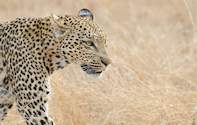

Leopards are such secretive creatures that estimates of the size of leopard populations can vary wildly, with scientific estimates in South Africa varying from 2,390 animals to 23,472 animals in the country.
The rangers at Londolozi Private Game Reserve in the Sabi-Sand Game Reserve adjoining the Kruger National Park have no such uncertainty about the leopard population in their 100km2 of protected area.
A ranger in Londolozi spotting a leopard will be able to identify the animal by the unique pattern of spots above their whiskers, and will probably be able to give you a complete breakdown of the animal's family tree. For the last 25 years, Londolozi's leopards have been carefully watched, and this year alone there have been over 780 individual sightings of the shy predators.
Ranger sightings provide a treasure trove of information, which has been kept in a database passed from ranger to ranger. Ranger Greg Seymour compiled leopard sighting information into an article for Conservation Corporation's Ecological Journal, which showcases findings from several Conservation Corporation lodges throughout Africa.
51 Leopards
He found that in an 11-month period, no less than 51 individual leopards were encountered on Londolozi. This included nomadic animals and cubs that died over the year. As the leopards have been monitored for so long, Seymour was able to track changes in the leopard numbers and territories over the years. He observed that cub mortality had increased from 50 percent in the early 1990s to almost 70 percent in the new millennium.
This increase seems to be largely due to there being more leopards in the area, with several males sometimes having overlapping territories. When these males encounter a territorial female in the area of overlap with cubs that are not their own, they often kill the cubs.
Over the 100km2 of the Sabi-Sands that the Londolozi rangers survey, in 2003 there were 14 female leopards occupying territories, with eight male leopard territories overlapping the female territories. Some of the male leopard territories only intruded partially into Londolozi, with the rest of the territory being in neighbouring land.
Territory
Territory sizes vary considerably, with females having smaller territories that can be under 15km2, while males can have territories up to 40km2. In the east of Londolozi, the leopards hold smaller territories, where there are higher impala densities.
Knowing the family tree of the leopards, it has regularly been seen in the Sabi-Sands that a mother leopard will move her territory sideways or decrease its size to allow daughter cubs to take over a portion of the territory when they reach maturity.
One female even left her entire territory to her young cub in 2000. Seymour noticed that it now seems that there is very little space for the mother leopards to move into, and some young females have to travel much greater distances to establish territories. Male leopards generally migrate away from their parents, and are believed to travel much greater distances before establishing a new territory.
The shrinking of a mother leopard's territory and potential food supply for her cubs is not as much of a problem as it may appear at face value. One leopard on Londolozi, known as the 3:4 female for her spot pattern, had eight litters of cubs from 1995 to 2004. Of these only cubs from the first litter and the fourth litter made it to sexual maturity. At least 10 other cubs died, one killed by a python, several killed by lions and others killed by territorial males.
Being 12 years old at the end of Seymour's study, the 3:4 female would only have a few reproductive years left. Ranger Cameron Apple, who has taken over from Greg Seymour in keeping tabs on all the leopard sightings, has said that there has been a considerable change in the territories over the last year, with a few adults dying and many cubs being lost.
This year there have been over 20 sightings of mating leopards, an unusually high number. Next year he plans to publish the new data gathered over the year in the Ecological Journal, continuing to grow the family trees of the Londolozi leopards. The Conservation Corporation Ecological Journal can be obtained from the wildwatch.com website, or by phoning (013) 744-3230.
By Melissa Wray

